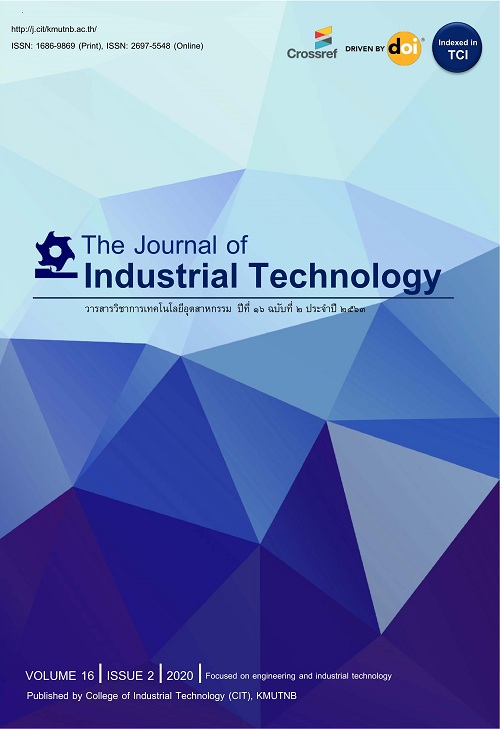Properties of Glass Fiber Reinforced Concrete Using Rubber Latex as an Ingredient
สมบัติของคอนกรีตเสริมเส้นใยแก้วที่ใช้ยางพาราเป็นส่วนผสม
Abstract
งานวิจัยนี้เป็นการศึกษาสมบัติทางกายภาพและทางกลของคอนกรีตเสริมเส้นใยแก้วที่ผสมด้วยยางพาราธรรมชาติ หรือยางพาราสังเคราะห์ สมบัติของคอนกรีตที่ศึกษาประกอบด้วย กำลังอัด การดูดซึมน้ำ และกำลังดัดของคอนกรีตเสริมเส้นใยแก้ว ตัวอย่างทดสอบกำลังอัดมีขนาด 50x50x50 mm เป็นไปตามมาตรฐาน ASTM C109 ส่วนตัวอย่างทดสอบกำลังดัดและการดูดซึมน้ำเป็นแผ่นบางคอนกรีตเสริมใยแก้วที่ได้จากการพ่นให้ได้ความหนาประมาณ 10 mm ตัวอย่างได้ถูกตัดให้มีขนาด 50x250 mm โดยตัวอย่างได้ทดสอบการดัดตามมาตรฐาน BS EN 1170-5:1998 ปริมาณสารลดแรงตึงผิวที่เหมาะสมสำหรับใช้ร่วมกับยางพาราธรรมชาติได้ถูกหาจากการทดลองผสมเพื่อหาความเข้ากันของส่วนผสม ตัวแปรหลักที่ทำการศึกษาประกอบด้วย ปริมาณเนื้อยางพาราธรรมชาติหรือเนื้อยางพาราสังเคราะห์ในอัตราส่วนร้อยละ 2 4 และ 6 แทนที่น้ำหนักปูนซีเมนต์ และอายุของตัวอย่างแผ่นบางคอนกรีตเสริมเส้นใยแก้วที่บ่มน้ำ 7 14 28 และ 56 วัน ผลการศึกษาพบว่า การใช้สารลดแรงตึงผิวที่ร้อยละ 1.0 ช่วยให้ยางพาราธรรมชาติผสมกับมอร์ตาร์ได้เข้ากันอย่างดีโดยไม่จับตัวเป็นก้อน การแทนที่ปูนซีเมนต์ปอร์ตแลนด์ด้วยยางพาราธรรมชาติหรือยางพาราสังเคราะห์ทำให้กำลังอัดของคอนกรีตมีแนวโน้มลดลง อย่างไรก็ดี การใช้ยางพาราธรรมชาติหรือยางพาราสังเคราะห์จะช่วยลดค่าการดูดซึมน้ำ โดยค่าการดูดซึมน้ำต่ำสุดเกิดขึ้นเมื่อใช้ปริมาณยางพาราธรรมชาติและยางพาราสังเคราะห์ที่ร้อยละ 2 นอกจากนี้ การใช้ยางพาราธรรมชาติหรือยางพาราสังเคราะห์ในตัวอย่างแผ่นบางจะทำให้หน่วยแรงดัดที่ขีดจำกัดสัดส่วนและหน่วยแรงดัดที่จุดแตกร้าวลดลงเมื่อเทียบกับตัวอย่างควบคุม แต่ค่าความเหนียวของตัวอย่างแผ่นบางมีแนวโน้มสูงกว่าตัวอย่างควบคุมเมื่อทำการบ่มน้ำในเวลานานขึ้น
This research is a study of the physical and mechanical properties of glass fiber-reinforced concrete (GRC) mixed with natural rubber latex or synthetic rubber latex. The properties studied include compressive strength, water absorption, and flexural strength of the concrete samples. The test samples for compressive strength had dimensions of 50x50x50 mm according to ASTM C109 standards. The test samples for flexural strength and water absorption were GRC thin plates prepared by spraying to a thickness of approximately 10 mm. Samples were cut into the dimension of 50x250 mm. All samples were tested under bending according to BS EN 1170-5:1998 standards. The appropriate amount of surfactant for use with natural rubber latex was determined through mixing trials to determine the compatibility of the ingredients. The main variables studied include: the amount of natural or synthetic rubber latex in the ratio of 2, 4, and 6 percent by weight of cement replacement. The samples were tested at different ages of 7, 14, 28 and 56 days after water curing. The test results found that using surfactant at 1.0 percent helped the natural rubber to mix well with the mortar without clumping. Replacing Portland cement with natural rubber latex or synthetic rubber latex tended to reduce the compressive strength of the mortar. However, the use of natural rubber latex or synthetic rubber latex would help to reduce water absorption. The lowest water absorption occurred when natural and synthetic rubber latex were used at 2 percent. In addition, the use of natural rubber latex or synthetic rubber latex in samples slightly decreased the stresses at limit of proportionality and modulus of rupture compared to the control sample. However, the toughness of the thin plate samples tended to be higher than those of the control samples when they were cured in water for a longer time.
Keywords
[1] ACI 544.1R-96, State-of-the-Art Report on Fiber Reinforced Concrete, American Concrete Institute, MI, 2002.
[2] N. Kabay and B. Amed, Glass fiber–reinforced sprayed concrete: Physical, mechanical, and durability properties, Journal of Materials in Civil Engineering, 2021, 33(1), 04020396.
[3] C. Sujivorakul, C. Jaturapitakkul and A. Taotip, Utilization of fly ash, rice husk ash, and palm oil fuel ash in glass fiber–reinforced concrete, Journal of Materials in Civil Engineering, 2011, 23(9), 1281-1288.
[4] A.J. Majumdar, B. Singh and J.M. West, Properties of GRC modified by styrene-butadiene rubber latex, Journal of Composites for Construction, 1987, 61-64.
[5] S. Mebarkia and C. Vipulanandan, Compressive behavior of glass‐fiber reinforced polymer concrete, Journal of Materials in Civil Engineering, 1992, 4, 91-105.
[6] P. Plangoen, The development of irrigation canal mix with rubber latex for farm irrigation system, KMUTT Research and Development Journal, 2016, 41(2), 211-223. (in Thai)
[7] T. Yaowarat, A. Suddeepong, M. Hoy, S. Horpibulsuk, T. Takaikaew, N. Vichitcholchai, A. Arulrajah and A. Chinkulkijniwat, Improvement of flexural strength of concrete pavements using natural rubber latex, Construction and Building Materials, 2021, 282, 122704.
[8] A. Buritatun, T. Takaikaew, S. Horpibulsuk, A. Udomchai, M. Hoy, N. Vichitcholchai and A. Arulrajah, Mechanical strength improvement of cement stabilized soil using natural rubber latex for pavement base applications, Journal of Materials in Civil Engineering, 2020, 32(12), 04020372.
[9] K. Zhong, M. Sun, M. Zhang, Y. Qin and Y. Li, Interfacial and mechanical performance of grouted open-graded asphalt concrete with latex modified cement mortar, Construction and Building Materials, 2020, 234, 117394.
[10] ASTM C109/C109M-02, Standard Test Method for Compressive Strength of Hydraulic Cement Mortars (Using 2-in. or [50-mm] Cube Specimens), ASTM International, PA 2002.
[11] BS EN 1170-5, Precast concrete products- Test methods for glass-fiber reinforced cement: Part 5 measuring bending strength, Complete bending test method, British Standards Institution, London, 1998.
DOI: 10.14416/j.ind.tech.2025.04.009
Refbacks
- There are currently no refbacks.






